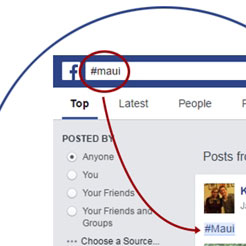What the Heck is a Hashtag? Social Media Tips for Baby Boomers & Beyond
Social media has made its mark on the world in more ways than one. And one of those marks is the hashtag! Have you ever found yourself browsing your Facebook feed and wondering, “what is a hashtag, anyway?” What’s all the hype? How do you use it? Why does my granddaughter have a t-shirt that says #YOLO?
Some of those questions are easier answered than others, but our social media expert at Road Scholar has taken a stab at answering some of the most-asked questions about hashtags here in the first edition of her social media tips for “Baby Boomers and Beyond” blog series.

What is a hashtag and how does it work?
The hashtag symbol is what touch-tone phone users will recognize as a pound sign (#). When the hash mark is placed before a word, that word becomes a tag. Hence the term “hashtag.”
Tip: If you’d like your hashtag to include more than one word, make sure you don’t include any spaces or punctuation between those words.
Examples: #Maui #RoadScholar #HappyNewYear #BabyBoomer #WorldsBestGrandma
A hashtag is added to a post on Facebook, Instagram or Twitter to tagthat post. That means that when a hashtag is added to a post, that post becomes searchable using that term.
Example: Let’s say I am posting a photo from my Road Scholar trip to Maui. If I add #Maui to the photo’s caption when I post it, then that photo will be tagged with the term “Maui.” That photo post is now “attached,” in a way, to other similar posts relevant to that term.
Now, let’s say my Facebook friend Joan is interested in going on a trip to Maui. Joan can search on Facebook for #Maui, and all of the photos that have been tagged with #Maui will appear in her search results, including the photo that I just posted.
Some common uses for hashtags
Travel: You can use hashtags to share messages or photos from your travels with your friends back home or with people you meet on your trip.
Hashtag Example: Let’s say I’m on a Road Scholar program. If I add #RoadScholar to the photos I post on Facebook, then others who have taken Road Scholar trips or are interested in Road Scholar can search for #RoadScholar to see other users’ photos or messages they’ve shared about Road Scholar on Facebook.
Another Hashtag Example: Even better, let’s say I’m on a Road Scholar program and all of my fellow participants and I select a special hashtag to use on social media, hashtag #RSinBranson. When I add this hashtag to my photos or other Facebook posts, then my new friends on my Road Scholar program can search for that hashtag and see everyone in the group’s posts from the trip!
Events: Some corporate or social events will select personalized hashtags that they will use in social media posts about the event and encourage others to use that hashtag.
Example: You’re attending the wedding of your niece. When you arrive at the reception, you see a chalkboard that says, “Please use our wedding hashtag! #ClairelovesJosh.”
When wedding guests take photos on their smartphone and upload them to Instagram or Facebook, the guests can use #ClairelovesJosh in the photo’s caption. Then, while the bride and groom are on their honeymoon, they can search for #ClairelovesJosh and see all the photos their friends took at their wedding!
News: We’ve talked a lot about using hashtags for photos, but hashtags can also be used to make conversations online about a certain topic, very often a topic that is “trending,” or a topic that lots of people around the world are talking about. It can be a national movement like #GivingTuesday or #IceBucketChallenge, or it can be a national or international topic like #Election2016 or #PrayforNice. You can even use hashtags to share or find news relevant to a particular topic, in real time.
Example: Let’s say there is a hurricane scheduled to arrive off the coast of Florida. You could search for #HurricaneMatthewon Twitter to get the most up-to-date information from other users on Twitter.
Similarly, if you live in Florida and you take a photo of the flooding in your yard after the hurricane has passed, you might post it to Twitter with the hashtag #HurricaneMatthew so that other Twitter users can see what kind of effects the hurricane had, in real time.
Using hashtags for news puts the power into the people’s hands, allowing them to share information without having to go through a media source.
What is a tag and how is it different from a hashtag?
A tag is similar to a hashtag except that it allows you to attach your post or photo to a particular person or page on Facebook. When you tag a person in a photo or a post, they will get a notification that they were tagged. This guarantees that your friend will be aware of the post so they can head over to your page to check it out.
To tag someone in a post, use an “at sign” (@) before you enter their name. Facebook will give you options on who you’d like to tag. You can tag people or pages that you follow, like Road Scholar.
Example: Let’s say I see this great article that Road Scholar posted on Facebook. I can share the article on my Facebook page and tag a few people who I think might be interested so they’re sure to see the article.
Now it’s Your Turn!
Head over to our Facebook page, follow us (if you’re not already) and be sure to use #RoadScholar and @rsadventures in your posts about Road Scholar, photos from your Road Scholar adventures or posts you think we might be interested in knowing about!


